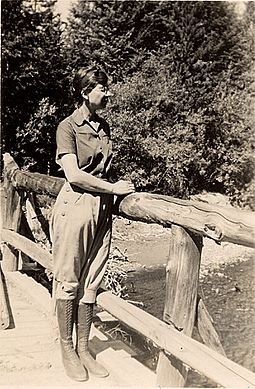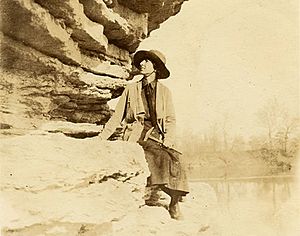Isabel Bassett Wasson facts for kids
Quick facts for kids
Isabel Bassett Wasson
|
|
|---|---|

Wasson on a bridge, circa 1920
|
|
| Born | January 11, 1897 |
| Died | February 21, 1994 (aged 97) |
| Nationality | American |
| Citizenship | United States |
| Scientific career | |
| Fields | Earth science, geology, ornithology |
Isabel Bassett Wasson (born January 11, 1897 – died February 21, 1994) was a truly special American scientist. She was one of the first women to become a petroleum geologist in the United States. This means she studied rocks and the Earth to find oil.
She also made history at Yellowstone National Park. Isabel was the first female ranger there. She was also one of the very first interpretive rangers hired by the National Park Service. Interpretive rangers teach visitors about the park's nature and history.
Contents
About Isabel's Life
Isabel Deming Bassett was born in Brooklyn, New York, on January 11, 1897. Her father, Edward Bassett, was a city planner. Her brother, Preston Bassett, became a famous inventor.
Isabel was a very smart student. In 1918, she graduated with high honors from Wellesley College. She studied history so she could take many different science classes. After college, she took geology classes at the University of Chicago and the Massachusetts Institute of Technology.
Her Family and Work
Isabel met her future husband, Theron Wasson, while studying geology at Columbia University. He was also a petroleum geologist. They got married in 1920. Isabel finished her master's degree in geology in 1934.
They had three children. Their daughter Elizabeth became a biologist. Their son Edward followed in their footsteps and became a petroleum geologist. Their other daughter, Anne, became an art historian.
From the early 1920s until 1928, Isabel worked as a petroleum geologist. She worked in her husband's office at the Pure Oil Company. She wrote important papers about geology. One paper was with her husband about an oil field. Another paper was by herself about the ages of rocks in Ohio. Her work was used by many other scientists.
Teaching and Nature
After 1928, Isabel lived in River Forest, Illinois for over 50 years. She taught science in local schools. She also gave many talks and loved watching birds, which is called ornithology. She helped many young naturalists learn about nature.
In 1986, a newspaper called the Chicago Tribune quoted her as an expert on local geology. She was 89 years old then! In 1982, a room in a local school was named the Wasson Room to honor her. It held local history resources.
Isabel was also interested in archaeology. In the 1930s, she found an ancient Native American site near her home. Some people say she helped start the environmental education movement in America. From 1953 to 1954, she was the President of the Chicago Ornithological Society, a bird watching club. She also taught classes at the Morton Arboretum in Illinois. Isabel Wasson passed away in 1994.
Yellowstone Park Ranger
Isabel Wasson was one of the first interpretive rangers hired by the National Park Service. She was also the second ranger and the first female ranger at Yellowstone National Park.
How She Became a Ranger
In the summer of 1919, Isabel was visiting Yellowstone with her family and friends. They were on a tour organized by a newspaper. She gave a lecture about geology to her group. Horace Albright, who was the park superintendent at the time, heard her talk. He was very impressed!
Albright invited Isabel to come back in the summer of 1920. He wanted her to lead tours and give talks about the park's geology. She agreed. She wrote to her college magazine, "Next summer I am to be a ranger in Yellowstone Park. You never heard of a woman ranger? Well, neither have I."
Her Impact at Yellowstone
That summer, Isabel gave over 200 public talks about the geology of Yellowstone. She showed how these talks should be done by park rangers. She helped create the way interpretive talks are still given today.
Albright also asked her to teach the hotel workers how to give similar talks. But Isabel realized they didn't know enough about geology. She suggested that the park hire college students on summer break instead. This idea became a tradition at Yellowstone and many other national parks.
Albright invited her to return in 1921, but she could not. She was starting a family. She asked about coming back in 1922, but others had already been hired for similar work. Isabel Wasson truly paved the way for women in science and in national parks.


